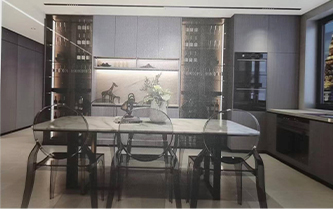- Dom
- A brief history of melamine-faced boards
tra . 28, 2024 16:21 Back to list
A brief history of melamine-faced boards
We come across melamine-faced boards in all different facets of our lives, from our bedrooms to our kitchens and our workplaces. Thanks to their versatility and wide range of finishes, these decorative boards have cemented their place as décor essentials in any home.
But what is the history of melamine-faced boards? In order to understand where melamine-faced boards come from we need to look at the history of particleboard and melamine respectively. Particleboard, which is made when wood offcuts and chips are combined with resin to create a sturdy piece of board, has been around since the late 1800s. A prototype of the modern particleboard was first invented in the late 1800’s when so-called “artificial wood” was created by combining a powder-like wood offcut and adhesive. It was only during the second World War, however, that particleboard as we know it today was invented. This was because a shortage of wood veneer led people to look for different solutions, inevitably winding up at a board made from ground up off-cuts and wood chips that had been mixed with a type of glue. It was during this time that the first commercial piece of modern particleboard was produced in a factory in Germany.
WOOD GRAIN PRINTING MELAMINE FILMS FOR FURNITURE DECORATION
So, when did melamine come into the picture? Melamine was first synthesized in the 1830s however it, much like Particleboard, only saw a rise in popularity during the second world war as it was used as an affordable way to make laminates and plastics that were exceptionally durable. It was in post-World War 2 North America, during the mid-20th century that melamine really became fashionable and it was during this time when melamine resin was first used to coat decorative paper that would then be laminated onto particleboard – resulting in the wood-based melamine panels we know today. These wood-based decorative panels are not only exceptionally durable and have excellent heat resistance, but the wide variety of styles available, their versatility and high-quality finishes has led to a steady rise in popularity since their inception.
As melamine boards have continued to see a rise in popularity, so too has the technology behind making these boards improved, leading to a higher quality of Particleboard and Medium Density Fibreboard, as well as a wider range of styles of decor paper. This has led to melamine boards being used to make a wider variety of products, from kitchen counters and cabinets, to office furniture and even bedroom cupboards.
Latest news
-
White Contact Paper for Cabinets – Transform Your Kitchen
VijestiJun.13,2025
-
Duplex Board Paper: Properties and Manufacturing Process
VijestiJun.13,2025
-
Food Packaging Solutions: Why Duplex Board is a Top Choice
VijestiJun.13,2025
-
Best Types of Furniture Decoration Paper
VijestiJun.13,2025
-
What Are the Best Adhesives for Applying Furniture Decoration Paper?
VijestiJun.09,2025
-
Key Properties and Uses of Duplex Board Paper in Packaging
VijestiJun.09,2025


